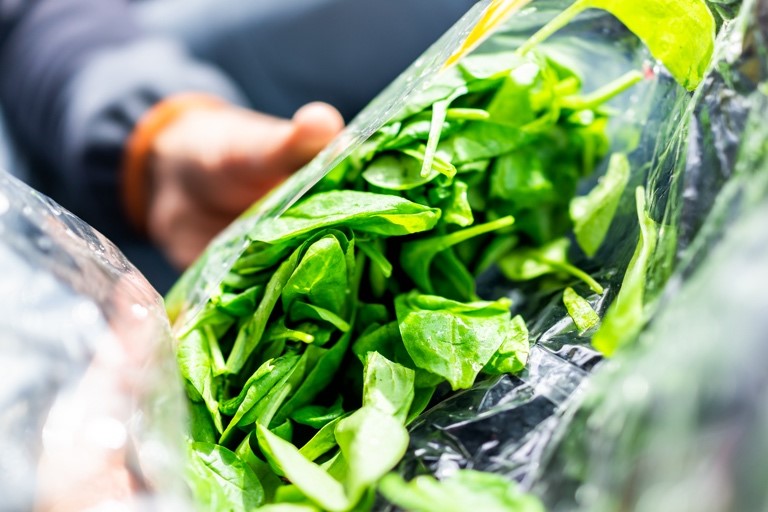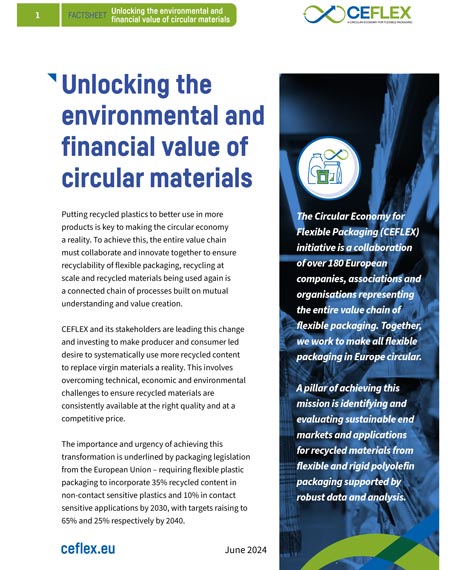How do we ensure the flexible packaging value chain aligns around delivering on circularity and recent legislative targets in recycled content?
The primary challenge today is insufficient demand for recycled materials. Either because they can sometimes not meet the required quantities and qualities end markets need or – most often – are more expensive than virgin materials. Currently, the primary recycling method is conventional mechanical recycling, which, in basic terms, produces a plastic pellet with a certain range of colour and use applications – the markets for which are finite.
How do we progress to where we want to be? Well, optimal design for recyclability is a foundation stone and helps accelerate the circular economy in three ways: boosting feasibility, increasing the efficiency of recycling and improving the quality of recyclate produced. We need converters and brand owners to continue pushing faster in this direction. With this in place, we can focus on the essential alignment between capacities, technologies and end market demand to bring ‘right quality’ recycled content aligned to new and existing applications keen to use more of it.
As markets for conventionally recycled plastics become saturated, a shift towards developing and using more advanced mechanical processes and ultimately chemical recycling capacities, which are not yet available at scale but are coming, becomes more important.
 We also need to establish or adapt sorting facilities to meet specific recycler bale specifications and optimise collection strategies. CEFLEX data suggests a significant portion of flexible packaging waste, up to 50% in many countries (and nearly 100% in some), still ends up in the residual waste stream, reflecting a considerable need to improve collection infrastructure and practices. Our testing programme results on Near-Infrared classification also reveals progress in these areas can be achieved by further optimising existing widely used technologies for instance.
We also need to establish or adapt sorting facilities to meet specific recycler bale specifications and optimise collection strategies. CEFLEX data suggests a significant portion of flexible packaging waste, up to 50% in many countries (and nearly 100% in some), still ends up in the residual waste stream, reflecting a considerable need to improve collection infrastructure and practices. Our testing programme results on Near-Infrared classification also reveals progress in these areas can be achieved by further optimising existing widely used technologies for instance.
How will CEFLEX’s Recycling Strategy help make these changes happen?
Over the past seven years, CEFLEX has been on a journey to define what a circular economy means for the sector and identifying the necessary steps for its implementation. This understanding leads our Recycling Strategy, which using this enhanced understanding of recycling needs, aims to deliver recycled materials that are competitively priced against virgin materials, either through market forces or mandated by legislation and all the while ensuring full transparency for those in the value chain. As this work is unchartered territory, we are currently in a steep part of the learning curve, but already sharing our new understanding more widely today – and further refining it in the coming months.
 Its focus on transparency is intended to level the playing field among all stakeholders, including recyclers, sorters, collectors, Extended Producer Responsibility (EPR) schemes, and brand owners, ensuring everyone can benefit while sustainably fulfilling their roles effectively. The strategy also aims to drive understanding of recycling because this determines the type of recycling technologies needed on the ground, the complementary collecting and sorting approaches required and how these should be aligned to the market.
Its focus on transparency is intended to level the playing field among all stakeholders, including recyclers, sorters, collectors, Extended Producer Responsibility (EPR) schemes, and brand owners, ensuring everyone can benefit while sustainably fulfilling their roles effectively. The strategy also aims to drive understanding of recycling because this determines the type of recycling technologies needed on the ground, the complementary collecting and sorting approaches required and how these should be aligned to the market.
By systematically allocating flexible packaging material waste streams through this approach, which factors in economic and environmental considerations, the strategy focusses on meeting the least demanding markets need first so as to minimise costs and environmental impact, then progressively moving to the more demanding ones, like films and ultimately food contact applications that require chemical recycling, even as these currently represent higher recycling costs and environmental impact. This approach is further facilitated by more circular design of flexible packaging because this affects both the feasibility and recycling efficiency, enabling actors across the value chain to align supply with demand and measure progress towards collective but increasingly mandatory recycling goals.
How can governance and policy levers be utilised to transition the value chain towards a circular future for flexible packaging?
Today, CEFLEX’s ‘Mission Circular’ vision – developed across the value chain first in 2017 – and the new PPWR legislative targets are happily converging to realise more circular materials.
Two key things need to happen: one involves achieving the mandatory recycled content targets as seen in the EU’s Packaging and Packaging Waste Directive, and the other involves appropriately funding Extended Producer Responsibility (EPR) schemes to ensure that the recycling rate targets can be met sustainably. These systems subsidise the collection, sorting and recycling processes for flexible but also rigid packaging industries, aiming to make recycled materials cost-competitive with virgin – also for non-packaging applications
I would also emphasise that to drive these changes effectively, collaboration is essential – not just nationally among recyclers and municipalities but also on a broader European scale, despite potential variations in the implementation of the circular economy across different countries. CEFLEX’s key ask of stakeholders here is to support this collective effort and strategic collaboration, including by the essential EPR/PRO scheme actors so together we can enact the complex balancing act of meeting recycling goals, managing financial constraints from funders and navigating the new legislative demands.

Graham Houlder,
CEFLEX Coordinator

